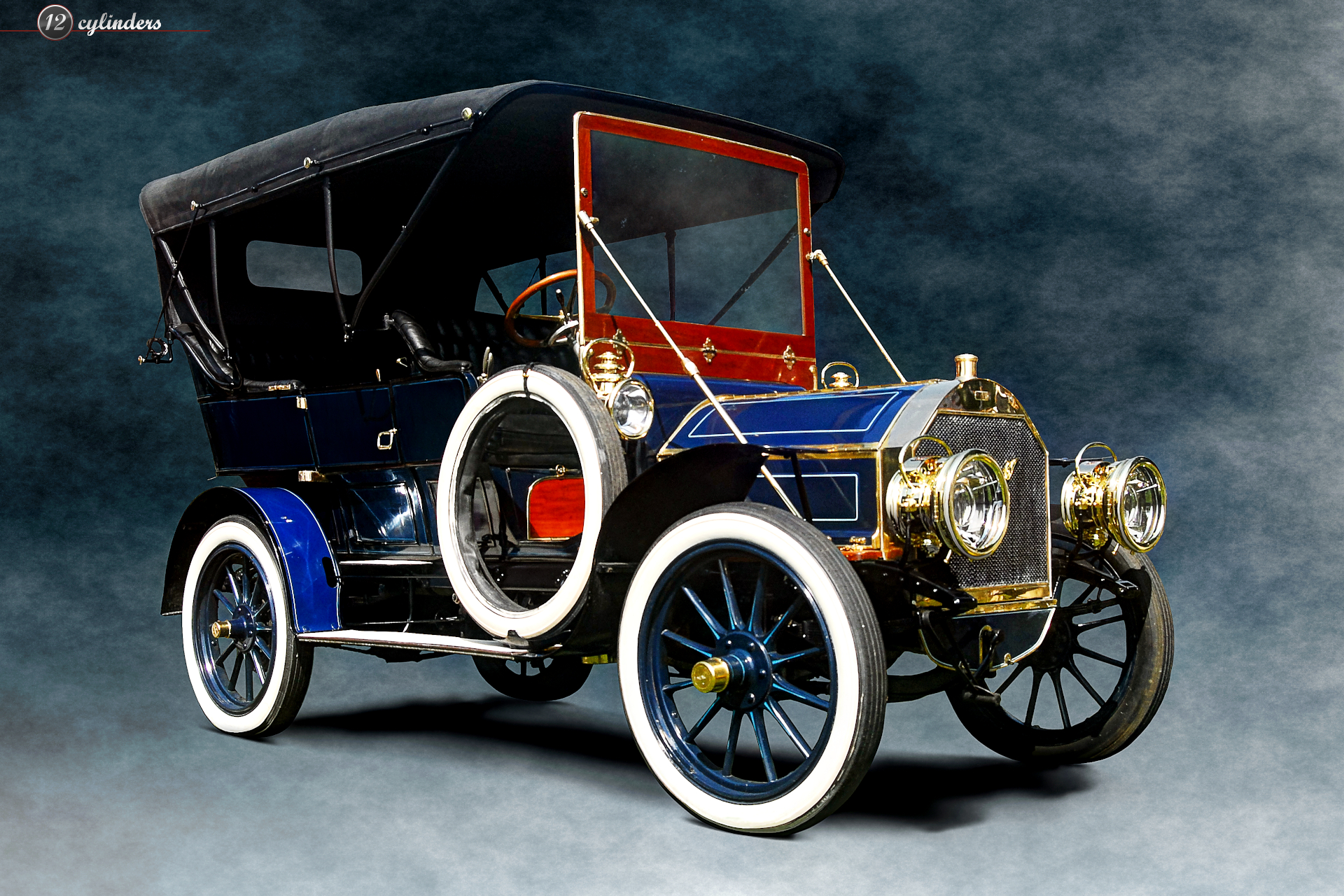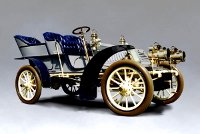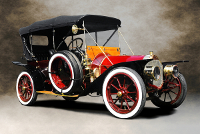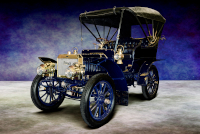Location:
Radnor Hunt Concours d'Elegance, 2007
Owner: Bill Alley | Greensboro, Vermont
Prologue:
Special thanks to Mr. David Donald, whose correspondence brought to life colorful anecdotes from his family history.
Only one old photograph... I have published profiles on classic cars for quite a long time. Very early in the endeavor, a photograph of Mr. Alley's Pierce Great Arrow sparked the first correspondence from a former owner. Now pursuing an in-depth Pierce-Arrow portfolio, I very much wanted to pull Mr. Donald's contribution and share his stories; they alone are worth featuring the car, to say nothing of its place in history. David grew up in New England, where his father owned this Pierce until selling the car onward to family friend, Dick Teague, known to the motoring world as industrial designer for General Motors, Packard, Chrysler, and of course American Motors Corporation. David wrote from Thailand, where he still lives. He is a jazz musician and director at Samui Sight & Sound Studios.
- - - - - - - - - -
► Image Source: Nikon D200 (10.2 MP)
References:
Marc Ralston's exceptional Pierce-Arrow book includes a photograph of this car on page 224, attending a Pierce-Arrow Society meet. At the time, the car was owned by Dick Teague and appeared with a windscreen but without a top.
- Mr. David Donald, former owner, written correspondence.
- Ralston, Marc. "Pierce-Arrow" A.S. Barnes & Co., Inc., San Diego, CA. 1980, page 33, 224, 230
- Ralston, Marc. "Pierce-Arrow, The Golden Age" Jostens Publications, Clarksville, TE. 1984, page 11
- Sears, Stephen W. "The Automobile in America" American Heritage Publishing Co, Inc., New York, NY. 1977, page 32-33, 73, 81
- Bonhams: This Model 28-32 NN goes to auction at Amelia Island in March, 2025.
This Great Arrow, one of the last surviving 1906 examples, returned to a fine home in New England. According to David, Dick Teague took it to Detroit for a spell, but otherwise the car spent nearly all its life in the northeast.
Inextricably linked to the Glidden Tour, the Great Arrow received top marques over five consecutive years, and perfect scores in four of those. The Tour was an international event with formidable equipment on hand, and a difficult trial for early motorcars to conquer. To emphasize the Great Arrow's success, in 1906 Pierce entered four cars on the 1,134-mile route from Buffalo to Québec to New Hampshire. All four cars received a perfect score.
Always the innovative company, the Great Arrow featured extensive use of aluminum—a pioneering step—and was among the first cars powered a six cylinder motor, which arrived the following year in 1907. The six-cylinder advantage over other manufacturers would last just a short time, but the use of cold-riveted aluminum would long remain a Pierce-Arrow bellwether.
The 'Great' in Great Arrow refers to size, particularly the height, which exceeds seven feet. Pierce offset the size of the car by using aluminum panels cold-riveted together, creating a body that is lighter than steel and also more tightly fastened, which in turn increases durability. The aluminum panels are not subject to rust and do not dent as easily as early steel counterparts. Not just the mechanical quality of the car, Pierce built the entire platform beyond industry standard.
Donald Family History and the Friendship of Industrial Designer Dick Teague
I am rarely so privileged to learn so much about a car's influence on those who care for it, even less so when the stories are as rich as those shared by Mr. David Donald.
Sometime after first editing this photograph (probably in late 2007), David reached out, recognizing the car as a dear part of his childhood. His father, George G. Donald, had purchased the car under rare circumstance. After breaking down out on the American highways, George walked to the nearest home to ask for help. There he discovered some relic of automotive history in the barn out back. His father returned to buy this Great Arrow the next day. That transaction happened in the late 1930s. The Great Arrow remained in his family in largely unfettered-with condition until George's passing in 1976, when industrial designer Dick Teague purchased the car.
David recounted tales of the automotive gatherings his family hosted in New England. "We used to have over one-hundred fifty cars in our large back yard and have a party. They would bring a huge teeter-totter and try to get the cars balanced with no side touching the ground—least angle from flat in shortest time wins. Model Ts were good at that." Of course the Oldsmobile Curved Dash Runabout became known for these sorts of balance exhibitions in period to advertise control and maneuverability. Ransom Eli Olds orchestrated the balancing act for publicity, in addition to mud-bogging and braking demonstrations.
As for the Pierce, David remembers that his father took the car to a church fair every year and offered $1 rides to raise money. During one of these jaunts, they managed to seat about eleven people in and on the Pierce. "We were heading on a run down across Sudbury River—a nice long hill down to the valley with only two rarely used roads toward the bottom. Dad opened up the hand throttle and a bit of spark advance, and we slid down the hill, only to hear a siren behind. We'd been doing 60 in a 45." The cop tried to be stern, until he got a handle on what he'd just pulled over.
"Registration says 1906... uh'm. What?! Is that right?" But what really knocked the policeman off his feet was that the tyre tread spelled out 'Goodrich.' The officer finally relented when he heard the ride was church connected, but asked George to keep the speed down.
While the Great Arrow remained in driving condition during its stay with David's family, it was not yet refurbished. After Dick Teague purchased the car, he scraped together a suitable windscreen and tonneau cover, both of which the car had done without for quite some time. Teague then refreshed the paint and pinstriping. David recalls that the man who touched up the pinstripes had been far older than the car itself—his hand shook mightily until just before it hit the metal, then ran smooth and straight.
"As far as we knew at the time of my last phone call with Dick Teague, there was no other '06 to be found whole, not even a chassis to steal parts from. There were parts in boxes labeled '06. There was an '05 and I think two '07s. But '06, she is the only one. It never had the roof or windshield during my time. But I think there was a rotted out frame that Dick got from us and he had it recanvased, and then a wood windshield frame was done from '05 and '06 photos."
The Pierce motorcar was known early on for steering-mounted transmission controls, dating back to the first 1903 Arrow, and David remembers much of the Great Arrow's operation. We commented to each other on the clap-trap noise the car makes on ignition, and he raised the topic of its peculiar starter system. "It had two ignition settings. If you put it to neutral you could crank it till one or two cylinders were primed with gas vapor, at just passed top of compression, then get in the cockpit and flip the lever. It would explode one then the other charge and have enough power to turn the motor over and keep it going. Never seen this done on another vehicle."
David also shared his recollections of Dick Teague. "I was in my early twenties then, driving a BMW 1600 with a 2002 engine. He thought that was a hoot. He sent me some of his design concepts. He had a minivan on a four-wheel-drive Pacer-sized chassis—fat, low tires under flared wheel wells, with swivel bucket seats and great looks to it. If AMC had built it, they would have created the minivan market and saved the brand. But the money guys said 'too radical.' Five years later it's minivan city and AMC is history." Better sentiments over the subject of the Pierce, "He always stayed in touch with my mother, telling her how the car was every three months or so. He got the car because he clearly loved it."
Motor: 4-cylinder, cast in pairs | 107.95 mm x 120.65 (4¼" x 4¾")
Valvetrain: T-head, single-plug
Power: 32 rated hp @ 1,600 rpm
Drivetrain: 4-speed sliding gear transmission, shaft drive to the rear wheels
Architecture: aluminum body panels cold-riveted together on a steel platform
Kerb Weight: 1,224.7 kg (2,700 lbs)
Wheelbase: 2,717.8 mm (107 inches)
Top Speed: 60 mph, downhill across Sudbury River with eleven church-going passengers, confirmed by the policeman who pulled them over
Etymology:
Pierce initially produced the Arrow and Great Arrow as distinct models. 'Arrow' officially joined the marque name (Pierce-Arrow) in 1908. The model number uses a rating of 28-32 designated horsepower. The 1906 28-32NN replaced the discontinued 24-28N of 1905. Pierce's increasingly cryptic alphanumeric system began respectably in 1901, not unlike most early manufacturers, whereas the progression from N to NN seems arbitrary, if only to distinguish an improved version. Above the 28-32NN, Pierce built the Model 40-45PP in 1906, which succeeded the Model 40-P. Pierce seems to have skipped the 'O' designation to avoid disambiguation issues with zero. Anyhow, as horsepower increased, the letters duplicated themselves.
Figures:
In 1906, Pierce offered the Model 28-32NN with a choice of four bodies, the tonneau, opera coach, suburban, and landaulet. The company produced 400 examples in 1906. Of those, one car survives. Similarly, only one of the original 300 1906 40-45PP cars survives as well.
Value:
The Model 28-32NN cost $5,000 in 1906.
Built Great: Pierce Dimensions and Luxury Stature
Both surviving 1906 cars use the tonneau body of a height comparable to Pierce closed cars of the early period from 1904 to 1906. At better than seven feet, 'great' extends in every dimension. Of the day, few manufacturers approached similar stature and prestige—Rolls-Royce of course, Peerless in the US, and the likes of Daimler and Delauney Belleville. The automobile concept being so new, marques produced for the upper echelon of society could afford to innovate, evident in Pierce's cast aluminum body. In this case, the Great Arrow represents less of what an automobile should be, (that question having been dispatched by Panhard et Levasseur), but rather how an automobile should be put together. Luxury in this case means more than size and strength, but rugged durability.
Built Blue: Early Color Designation on the Pierce Great Arrow
Marc Ralston notes that "the 28-32NN regularly came in dark blue with light blue striping," whereas Pierce painted the 40-45PP in Brewster green. Thus, the color alone identifies the model.
Build Simplicity: Great Arrow Design Components
The motor's box section forms a massive chest, as if hauled out of a ship's hold, but the extreme height of the windscreen exacerbates the car's childlike proportions, too big and too tall. The gap between the front tyre and fender somewhat misaligns the running gear, whereas the rear fender settles appropriately relative to the tonneau body and rear tyre. Any discrepancy in the fenders seems to be inadvertent, a factor of the period. But design is not Pierce's calling card. Style equals substance, which the Great Arrow provides in volume.
Coach Height: The Meaning of 'Great' in Terms of Dimension and Personal Liberty
Compare the height of each step required to board the car with the demi-tonneau or miniature tonneau. The position is stagecoach-worthy, keeping occupants far away from the dash and dirt below. Particularly in an open car, distance from the ground translated to social rank. At the turn of the century, a personal motorcar provided its owner the ability to escape the city, or even to escape one's estate, and simply travel wherever, whenever. That sense of freedom does not look so glamorous today in old monochrome photos, and yet contemporary all-wheel-drive vehicles hearken back to the same liberty. For the owner to complete a 1,000-mile journey with the assurance of no undue trouble along the way justified the cost in an era when few could attempt such a trip without the help of a railroad.
Last Updated: Mar 26, 2025




